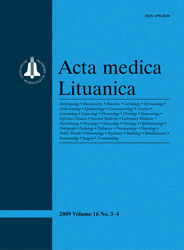Acta medica Lituanica
 ISSN 1392-0138 ISSN 2029-4174 (online) |
2011 m. Nr. 2 Integral approach to the quality of life conditioned by
health
Background. Currently, there are a lot of methodologies for evaluating the quality of life both in West Europe and in the USA. The majority of them are grounded on the multi-disciplinary, systemic principles. Meanwhile, in some countries and in Lithuania, the studies of the quality of life are more focused on the fields of health and medicine. According to the modern conception of sustainable development, the quality of life is a result of an integral interaction of quality of life indicators. The modern concept of the quality of life is a particular social construct comprising different social dimensions.
Materials and methods. A sample of 1 200 persons was formed under the quota of age and gender. Its main point is that the health, social, economic, environmental and age elements of the quality of life comprise an integral, purposeful social system. Statistical analysis was carried out using SPSS 17.0. The data were analyzed using the method of factorial analysis which accounts for the correlations among all indicators. Six latent factors were determined, and they explained 45.55% of the general dispersion. The position of beliefs was determined as the underlying latent factor formed by spiritual and social indicators. This factor explained 10.51% of the general dispersion. Also, in the systematic process, another latent factor – the need for medical services – plays an important role which increases with age, especially in people aged over 50 years. Results. The results showed that at about 50 years all latent factors acquire negative values, i. e. at the age of about 46–50 years the social risk of the quality of life, determined by health, becomes greater. Conclusions. The research helped to determine qualitative changes in the quality of life at the age of 45–50 years when essential changes in the priorities of the quality of life occur in all its domains. Keywords: integral approach, quality of life, social link, integrity |
Issues:
2011 - Vol.18 No. 1, No. 2, No. 3, No. 4 2010 - Vol.17 No. 1-2, No. 3-4 2009 - Vol.16 No. 1-2, No. 3-4 2008 - Vol.15 No. 1, No. 2, No. 3, No. 4 2007 - Vol.14 No. 1, No. 2, No. 3, No. 4 2006 - Vol.13 No. 1, No. 2, No. 3, No. 4 2005 - Vol.12 No. 1, No. 2, No. 3, No. 4 2004 - Vol.11 No. 1, No. 2, No. 3, No. 4 2003 - Vol.10 No. 1, No. 2, No. 3, No. 4 2002 - Vol.9 No. 1, No. 2, No. 3, No. 4 2001 - Vol.8 No. 1, No. 2, No. 3, No. 4 |